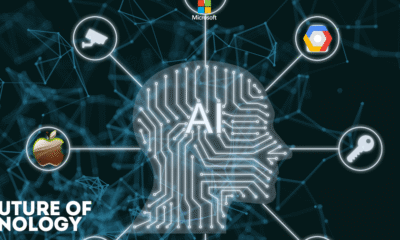Artificial Intelligence
Breaking Generative AI News: Innovations Shaping the Future of Technology

Generative AI is making waves across various sectors, revolutionizing how we think about innovation and creativity. This technology, which creates new content rather than just analyzing existing data, is reshaping industries from healthcare to entertainment. In this article, we’ll explore the latest generative AI news, highlighting the innovations that are set to transform our future.
Key Takeaways
- Generative AI speeds up the innovation process by enabling rapid idea generation.
- It enhances collaboration between humans and machines, leading to better outcomes.
- AI can identify patterns that humans might miss, opening doors to new ideas.
- While generative AI has many benefits, challenges like data bias must be addressed.
- The technology is evolving quickly, with advancements in fairness, explainability, and multimodal capabilities.
The Future of Innovation with Generative AI

Generative AI is really changing things. It’s not just about making cool pictures; it’s about how we come up with new ideas and inventions. It’s like having a super-powered brainstorming partner that never gets tired. This could lead to breakthroughs we can’t even imagine yet.
Accelerating the Innovation Process
Think about how long it usually takes to go from an idea to something real. Generative AI can make that process way faster. It can analyze tons of data, spot patterns, and suggest new approaches in a fraction of the time it would take a human. It’s like fast-forwarding through the boring parts so you can get to the good stuff sooner. This is especially important as business leaders prepare for this AI-driven future.
Fostering Human-AI Collaboration
It’s not about AI replacing people; it’s about AI and people working together. AI can handle the data crunching and generate initial ideas, but humans bring the creativity, critical thinking, and real-world knowledge. It’s a team effort where each side brings something unique to the table. Imagine inventors using generative AI algorithms to explore a wider range of possibilities, overcoming mental roadblocks and exploring uncharted territories of innovation.
Unlocking New Opportunities
By speeding up innovation and helping people come up with new ideas, generative AI can open up all sorts of new opportunities. It can help us solve problems we didn’t even know we had and create products and services we never thought possible. It’s like opening a door to a whole new world of possibilities. The potential benefits of Generative AI in the innovation process are immense. By accelerating the pace of innovation, reducing costs, and democratizing access to the patent system, Generative AI has the power to unlock new opportunities and drive economic growth.
Unleashing the Power of Idea Generation
Generative AI is changing how we come up with new ideas. It’s not just about replacing human creativity, but more about making it stronger. By looking at tons of data, AI can find connections and suggest ideas that we might miss. It’s like having a super-powered brainstorming partner.
Transforming Traditional Brainstorming
Remember those brainstorming sessions where you sit around a table, throwing out ideas? Generative AI takes that to a whole new level. It can analyze huge amounts of information – scientific papers, market trends, existing patents – and find patterns that humans can’t see. This means we can come up with ideas that are totally new and different. It’s not just about incremental improvements; it’s about AI idea generator that can lead to real breakthroughs.
Identifying Hidden Patterns
AI is great at spotting patterns. It can look at data from different fields and see connections that would normally be hidden. For example, it might find a new way to use a material based on research from a completely different industry. This ability to connect the dots can lead to unexpected and innovative solutions. It’s like having a detective that never sleeps, always looking for clues to the next big thing.
Amplifying Human Ingenuity
Generative AI isn’t meant to replace human inventors. Instead, it’s a tool to help them be even more creative. It can help us explore more possibilities, get past mental blocks, and discover new areas of innovation. Think of it as a creative assistant that can help you take your ideas further than you ever thought possible. It helps with WordPress development services and other areas.
Empowering Inventors: The Advantages of Generative AI

I was just reading about how generative AI is changing the game for inventors, and it’s pretty wild. It’s not just about replacing human creativity, but more about giving inventors superpowers. Think of it as a super-smart assistant that can help you brainstorm, design, and even handle some of the legal stuff. It’s like having a whole team working for you, but without the coffee breaks and office politics.
Enhanced Speed in Ideation
One of the biggest advantages is speed. Generative AI can churn through tons of data and spit out potential solutions way faster than any human could. It’s like having a turbo button for your brain. Instead of spending weeks or months just trying to come up with ideas, you can get a bunch of options in a matter of hours. This lets inventors focus on refining the best ideas instead of getting bogged down in the initial brainstorming phase. It’s a total game-changer for getting affordable biologics to patients faster.
Cost Reduction in Development
Developing new inventions can be crazy expensive. Prototypes, testing, revisions – it all adds up. Generative AI can help cut costs in a few ways. First, it can simulate designs and predict how they’ll perform, reducing the need for physical prototypes. Second, it can automate some of the more tedious tasks, freeing up inventors to focus on the high-level stuff. It’s like having a virtual lab assistant that works 24/7 without asking for a raise. Here’s a quick look at how costs can be affected:
| Stage | Traditional Cost | AI-Assisted Cost | Potential Savings |
|---|---|---|---|
| Prototyping | $10,000 | $2,000 | $8,000 |
| Testing | $5,000 | $1,000 | $4,000 |
| Legal (Patent) | $7,000 | $3,000 | $4,000 |
Democratizing Access to Innovation
Traditionally, inventing was something that mostly happened in big companies or universities with tons of resources. But generative AI is leveling the playing field. Now, anyone with a good idea and a computer can access powerful tools to help them develop and draft patent applications. It’s like giving everyone a shot at being an inventor, regardless of their background or resources. This could lead to a surge of new ideas and innovations from unexpected places. It’s a pretty exciting time to be an inventor, that’s for sure.
Navigating Challenges in Generative AI
Generative AI is cool, but it’s not all sunshine and rainbows. There are definitely some potholes in the road we need to watch out for. It’s not just about making cool pictures; it’s about doing it responsibly. Let’s talk about some of the trickier parts.
Addressing Data Bias
Okay, so here’s the deal: AI learns from data. If that data is messed up – biased, skewed, whatever – the AI will be too. It’s like teaching a kid with a textbook full of lies; they’re going to believe the lies. We need to be super careful about the data we feed these things. Think about it like this:
- Check the data sources.
- Actively look for imbalances.
- Use techniques to correct for bias.
It’s a pain, but it’s important. Colleges and universities are facing similar issues when implementing AI literacy programs.
Ensuring Ethical Use
This is a big one. Generative AI can be used for some seriously shady stuff. Deepfakes, fake news, you name it. We need to have some rules in place, and people need to actually follow them. It’s not enough to just say, "Oh, we’re being ethical." We need to prove it. Think about:
- Transparency in how AI is used.
- Accountability for AI-generated content.
- Regulations to prevent misuse.
The Role of Human Expertise
AI is a tool, not a replacement. You still need people who know what they’re doing. An AI can spit out a million ideas, but someone needs to be able to tell the good ones from the bad ones. Someone needs to understand the manufacturing constraints and the real-world implications. It’s a partnership, not a takeover. The human element is still key. Consider these points:
- Humans provide critical thinking.
- Humans ensure alignment with values.
- Humans adapt to unexpected situations.
The Evolution of Generative AI Technologies
From Statistical Models to Deep Learning
Generative AI has come a long way! Early attempts at creating content with machines relied on simple statistical models and rule-based systems. These were okay, but they couldn’t really produce anything that felt truly original or high-quality. The shift to neural networks in the 90s and early 2000s was a game-changer. These networks could learn from complex data, opening the door for more sophisticated AI. Autoencoders were a big step, allowing machines to compress and reconstruct data. Then came variational autoencoders (VAEs), which added probabilistic modeling to the mix, making it possible to generate more realistic variations.
Key Innovations in AI Architecture
Several key innovations have propelled generative AI forward. Generative Adversarial Networks (GANs), introduced in 2014, use two competing neural networks (a generator and a discriminator) to improve the quality of generated content through adversarial training. The generator tries to create realistic outputs, while the discriminator tries to tell the difference between real and fake data. This back-and-forth pushes both networks to get better and better. Then there are transformer architectures, like GPT, which use self-attention techniques to process and generate text in a contextually rich way. Diffusion models, like DALL·E and Stable Diffusion, generate images by refining noise over multiple iterations. These models have greatly improved the quality and control of AI-generated images.
Impact on Various Industries
Generative AI is already having a big impact across many industries. In healthcare, it’s being used to design new drugs and personalize treatment plans. In media and entertainment, it’s revolutionizing content creation, making it easier to generate realistic images, videos, and music. In finance, it’s being used to detect fraud and automate tasks. And in business automation, it’s helping companies streamline their operations and improve efficiency. The ability of generative AI to create human-like outputs is blurring the line between machine-generated and human-generated content. Here’s a quick look at how it’s impacting a few key sectors:
- Healthcare: Drug discovery, personalized medicine
- Media: Content creation, special effects
- Finance: Fraud detection, risk management
- Business: Automation, customer service
Real-World Applications of Generative AI
Generative AI isn’t just some futuristic concept anymore; it’s already making waves across various industries. It’s changing how we do things, from creating content to developing new medicines. It’s pretty wild to see how quickly it’s being adopted.
Transforming Healthcare Solutions
Generative AI is showing real promise in healthcare. Think about it:
- It can help design new drugs by predicting how molecules will interact. This speeds up the research process a lot.
- It can generate realistic medical images for training purposes, which is way better than using outdated textbooks.
- It can even personalize treatment plans based on a patient’s specific genetic makeup. That’s some next-level stuff.
It’s not going to replace doctors anytime soon, but it can definitely make their jobs easier and improve patient care. For example, Citi leverages Vertex AI to enhance generative AI capabilities throughout the organization.
Revolutionizing Content Creation
Content creation is another area where generative AI is making a huge impact.
- Need a blog post? AI can write it.
- Need a script for a video? AI can do that too.
- Need some cool images for your website? You guessed it, AI can generate those as well.
It’s not always perfect, and you still need a human to review and edit the output, but it can save a ton of time and effort. Plus, it’s democratizing content creation, allowing smaller businesses and individuals to produce high-quality material without breaking the bank. It’s like having a whole team of creatives at your fingertips. The models like GPT-4 have transformed sectors like marketing, customer service, and journalism by increasing productivity and scalability.
Enhancing Business Automation
Beyond healthcare and content creation, generative AI is also being used to automate various business processes.
- It can generate code for software applications, which can speed up development cycles.
- It can create realistic simulations for training employees, which is way more engaging than traditional methods.
- It can even personalize customer interactions, making them feel more valued and understood.
Basically, if there’s a task that involves generating something, there’s a good chance that generative AI can help automate it. This can lead to increased efficiency, reduced costs, and improved customer satisfaction. It’s a win-win for everyone involved.
Future Trends in Generative AI Development
It’s wild to think about where generative AI is headed. Things are moving so fast! We’re already seeing some pretty amazing stuff, but the next few years are going to be even more interesting. Here’s what I’m keeping an eye on:
Increased Fairness and Bias Mitigation
One of the biggest problems with current AI models is that they can be biased. This happens because they’re trained on data that reflects existing inequalities in society. The future of generative AI depends on making these models fairer and less biased. Researchers are working on ways to detect and fix these biases, but it’s a tough challenge. It’s not just about technical solutions, but also about making sure the data we use is more representative and inclusive. We need to consider the ethical use of AI in every step.
Advancements in Explainable AI
Right now, a lot of AI is like a black box. You put something in, and you get something out, but you don’t really know how it got there. This is a problem because it makes it hard to trust AI, especially when it’s making important decisions. Explainable AI (XAI) is all about making AI more transparent. The goal is to develop models that can explain their reasoning, so we can understand why they made a particular decision. This is super important for things like healthcare and finance, where you need to be able to justify your actions. Here’s a quick look at the progress:
- Current State: Limited transparency, difficult to understand decision-making processes.
- Future Goal: AI models that can clearly explain their reasoning and outputs.
- Benefits: Increased trust, better accountability, easier debugging.
Multimodal Generative Models
Imagine an AI that can create not just text, but also images, music, and even videos, all at the same time. That’s the promise of multimodal generative models. These models can understand and generate content in multiple formats, which opens up a whole new world of possibilities. For example, you could ask an AI to write a song and then create a music video to go with it. Or you could ask it to design a product and then create a 3D model of it. The potential applications are endless. The first GPT models were a big step, and we’re just getting started.
Looking Ahead: The Generative AI Revolution
As we wrap up our look at generative AI, it’s clear that this tech is shaking things up in a big way. Sure, there are bumps in the road, like data bias and the need for human know-how, but the upside is huge. Generative AI is speeding up how we come up with new ideas and making it easier for more people to get involved in innovation. It’s not just about machines doing the work; it’s about teaming up with them to push boundaries we never thought possible. The future is bright, but it’s going to take all of us—inventors, tech developers, and lawmakers—to make sure we’re using this power responsibly. So, let’s keep the conversation going and see where this journey takes us.
Frequently Asked Questions
What is Generative AI?
Generative AI is a type of artificial intelligence that creates new content, like text, images, or music, based on the information it learns from. Instead of just analyzing data, it can come up with original ideas.
How does Generative AI help with innovation?
Generative AI speeds up the process of coming up with new ideas. It can analyze a lot of information quickly and suggest solutions that humans might not think of right away.
What are some benefits of using Generative AI for inventors?
Inventors can work faster and save money when using Generative AI. It helps them explore many ideas quickly, making it easier to find new inventions.
What challenges does Generative AI face?
Generative AI can have problems like data bias, where the information it learns from is unfair. It’s also important to have human experts to check if the AI’s ideas are practical.
How has Generative AI changed technology?
Generative AI has transformed how we create content. It’s used in many fields, like healthcare and entertainment, making it easier to innovate and solve problems.
What trends are shaping the future of Generative AI?
Future trends include making AI fairer and easier to understand, as well as developing models that can create different types of content, like text and images together.
-

 Cybersecurity6 days ago
Cybersecurity6 days agoIs Your Privacy at Risk? What You Need to Know About New Data Regulations in 2025
-

 Digital Privacy7 days ago
Digital Privacy7 days agoThe Biggest Data Breaches of 2025 – And How to Protect Yourself
-

 Technology5 days ago
Technology5 days agoApple, Google, Microsoft: How Big Tech Is Shaping the Future in 2025
-

 Blockchain Technology6 days ago
Blockchain Technology6 days agoTech Stocks to Watch: The Biggest IPOs and Market Trends in 2025
-

 Cybersecurity6 days ago
Cybersecurity6 days agoTop 5 Cybersecurity Tips to Keep Your Personal and Business Data Safe in 2025
-

 Banking7 days ago
Banking7 days agoUS Credit Rating Downgraded by Moody’s: A Wake-Up Call for Fiscal Responsibility
-

 Business4 days ago
Business4 days agoS&P 500 Extends Winning Streak Despite Moody’s Downgrade
-

 Press Release6 days ago
Press Release6 days ago$UR Token Explained: The Engine Behind URSWAP’s Cross-Chain Ecosystem


















